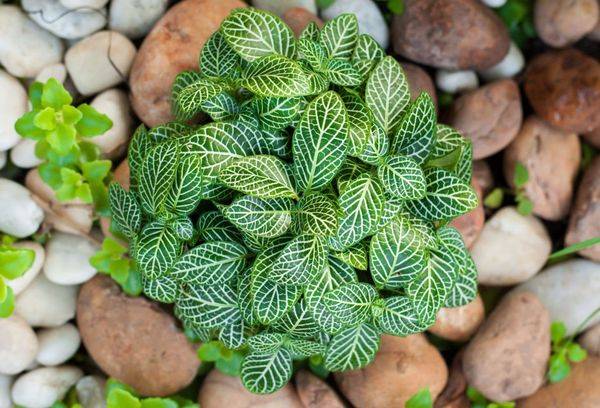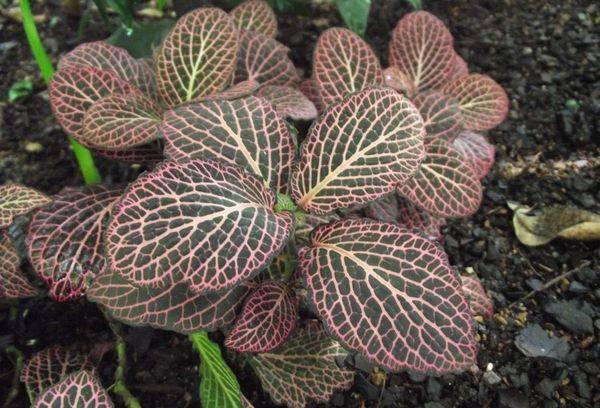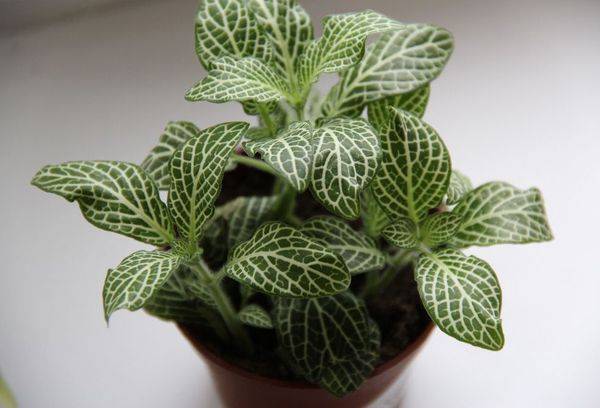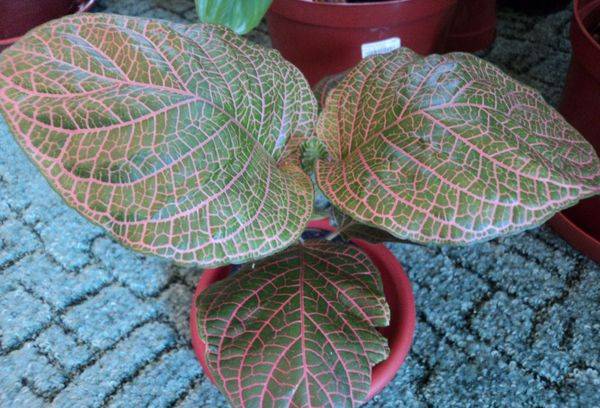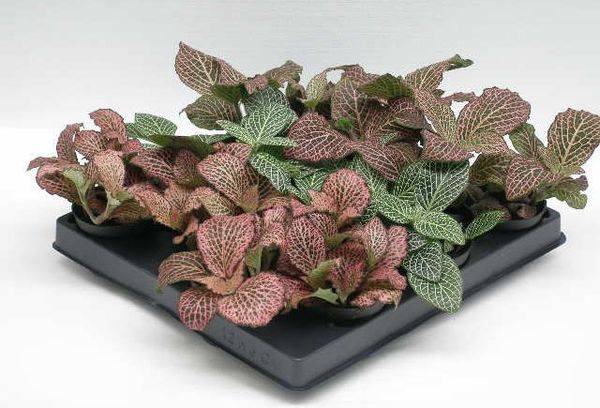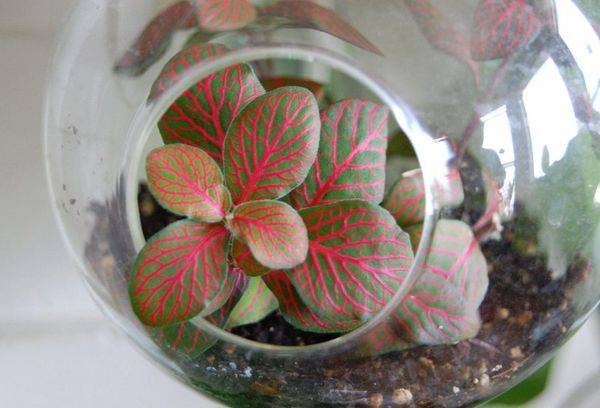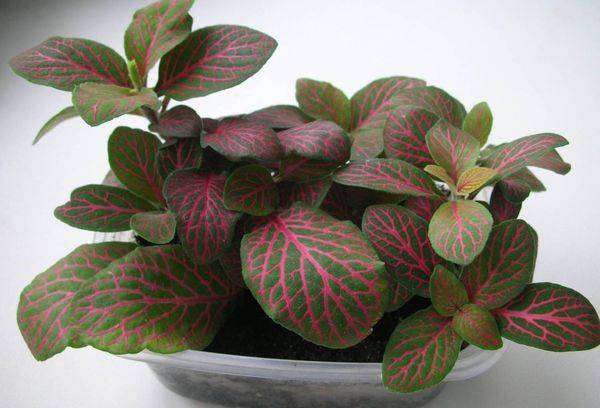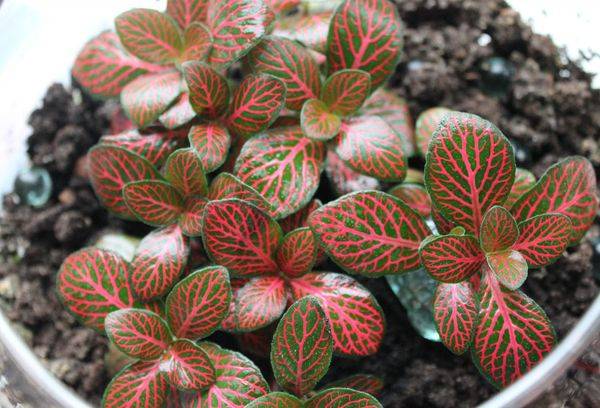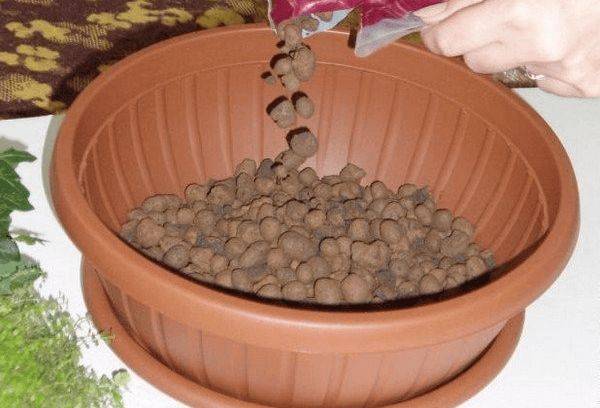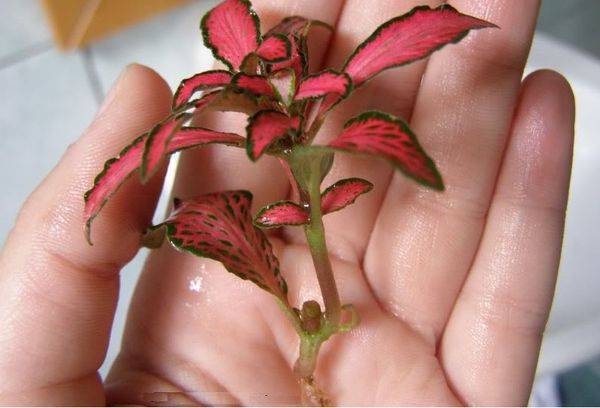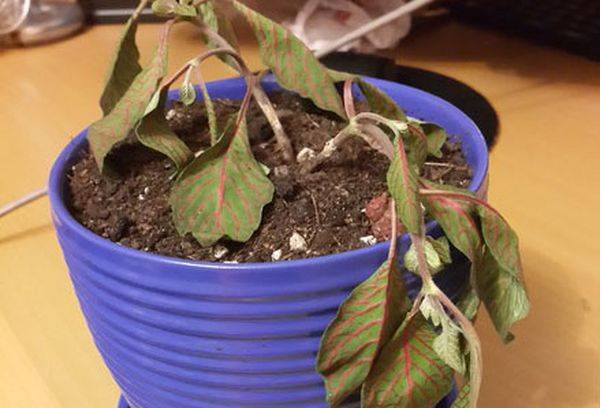How to properly care for fittonia at home
Content:
Proper care of fittonia at home ensures good plant growth and development. The main thing is to maintain a stable temperature and high humidity in the room. Sharp fluctuations in temperature and insufficient humidity are literally fatal to a flower. The plant is ideal for growing in a "bottle garden", phytoterrarium or paludarium, which will become an original and attractive decoration of the interior.
Description
The genus Fittonia belongs to the acanthus family and includes 4 species of plants: 3 of them have creeping shoots, 1 is upright. The homeland of Fittonia is the marshy covered forests of Peru. The plant is not distinguished by rapid growth and shade tolerance, it is demanding on the growing conditions, therefore it is considered a problem flower.
Fittonia is characterized by very short and thin pubescent shoots. The flowers of the plant have a nondescript appearance, small, sulphureous yellow, sessile, form spike-shaped inflorescences, single. The beautiful appearance of Fittonia is ensured by leaves, the length of which varies from 2 to 16 centimeters, depending on the species. Leaf plates have an ovoid shape, are located along the entire length of the stem, green, with streaks of bright colors. Fittonia are usually grown as ampelous or groundcover plants.
Kinds
Spread in indoor floriculture is far from all known types of Fittonia. Only 4 of them gained relative popularity:
- Fittonia Vershaffelt - a plant with pubescent leaves and stems, ground cover. There are pink streaks on the green leaves.
- Silver Fittonia (silver-veined, white-veined) - erect bush with oval green leaves, on which there are streaks of silver-white color.
- Giant fittonia grows to a height of 60 cm. It is an upright bush with dark green leaves. On leaf plates there is a pattern of carmine red veins.
- Fittonia mix blooms in late June or early July with small yellow flowers. The main decoration of the species is red, green, lilac or white oval leaves with a matte surface. The veins are clearly visible and come in dark green, white, pink or silver.
Lighting
Ideal for growing Fittonia is diffused bright light. From direct sunlight, the plant must be protected, as they can destroy it. The flower will feel good on the windowsill of a window facing west or east. It is acceptable to put the pot on the north window.
In a dark corner, the leaves of Fittonia will quickly lose their decorativeness, and the shoots will begin to stretch, the appearance as a whole will be sluggish and stunted. Therefore, in the winter months, it is necessary to supplement the plant with phytolamps or ordinary daylight lamps. The poorer the illumination, the less bright the veins on the leaves will be bright, strong shading with a high probability will provoke a complete disappearance of the picture. The pattern will be as catchy and contrasting as possible only if the plant is grown in soft diffused light.
To obtain the perfect color, the best option is a combination of natural and artificial light. In this case, the power of the fluorescent lamp should be 36 watts. The rays of the setting sun will not harm the plant.
Temperature
Fittonia begins to hurt if the thermometer in the room drops below + 18 ° C, regardless of the time of year. In the summer months, the temperature will be optimal from +22 to + 25 ° C, in winter it should be slightly colder.
It is strictly forbidden to take the flower to a balcony or open air, as drafts and sharp temperature changes will lead to leaf falling, and in some cases to the death of the plant. The combination of high humidity and low temperature is also fatal for fittonia.
Tip
In frost, remove the plant from the windowsill.
Hypothermia of the flower most often occurs in the fall and spring, when the air temperature is quite low, and the heating has not yet been turned on or has already been turned off. This is especially pronounced in plants located on the windowsill. Save the fittonia from hypothermia a pot shrouded in insulating material.
Watering, spraying, humidity
Proper watering ensures health and excellent flower growth. The need for water depends on the air temperature in the light room: the warmer and lighter, the more water you need to water. The main thing is not the amount of water, but the intervals between irrigation. The size of the pot should be taken into account: the larger it is, the better moisture is retained and, accordingly, watering is less necessary.
Tip
Observe fittonia from the first days of care and how quickly the soil in the pot dries. On average, water the plant once a week until excess moisture seeps into the pan. After half an hour, remove excess water.
From spring to autumn, watering should be plentiful, an earthen coma should not be allowed to dry out - it should be drained 1-1.5 cm. Water should be watered with well-settled soft water. Fittonia evaporates moisture with leaves, which ensures rapid drying of the substrate. The roots are extremely sensitive to excess and lack of moisture. Even if the drying of the root system was only once, the leaves may fall. The soil should be kept slightly moist at all times and only slightly dry between waterings.
In autumn, the amount and frequency of watering should be reduced, moisten the soil in 2-3 days, not more often. In the winter months, the plant does not have a pronounced dormant state, but its growth slows down. At a low temperature in the room, watering must be further reduced.
Tip
purityis.decorexpro.com/en/ recommends not spraying, because after them there will be stains and spots on the leaves that spoil the appearance of the plant. To maintain optimum humidity, place the pot on a pallet containing wet sand or expanded clay.
The plant can be flooded with watering for the future. Also, do not water Fittonia through the pan.
Optimal air humidity is a guarantee of a good flower development; it should be in the range of 70-75%, regardless of the season. In this case, periodic ventilation and good air exchange are necessary, there should be no stagnation of air, as well as drafts.
Top dressing
Every 2 weeks from March to October, it is necessary to fertilize the plant with organic or complex mineral fertilizers. The dose should be half of the recommended for other plants. This is because phytonia is extremely sensitive to excess nutrients in the soil.
In winter, feeding should not be stopped, it is necessary to do them no more than once a month. In this case, the concentration of the solution should be further reduced. The basic rule of feeding Fittonia: than to fertilize in excess, it is better to underfeed.
Tip
Once every 1-1.5 months, spray the plant with a solution of the growth regulator "Epin-Extra", which has a wide spectrum of action. The concentration of the solution should be very weak: for 1 liter of water, take 1-2 drops of the product.
It is allowed to feed the plant alternately with organic and mineral fertilizers. Do not fertilize Fittonia if the earthen lump is dry. First moisten the soil and only the next day pour a solution of fertilizer.Otherwise, there is a danger of burning the roots. You should not feed the plant immediately after planting.
Relocation
Fittonia needs an annual transplant, which must be done in the spring in March or April. The root system of the plant is located close to the surface of the soil, because a wide, but shallow pot is the best option for transplanting.
Resettlement is carried out by the method of transshipment, since the stems of the plant are fragile, and the root system is easily damaged. A ready-made substrate, for example, "Violet", "Azalea", "Geranium", which is widely represented in the flower shop, is suitable. To prepare the soil for Fittonia yourself, take in equal quantities deciduous and coniferous soil, peat soil and sand. Another soil option:
- 2 parts of soddy soil;
- 2 parts of coniferous land;
- 1 part peat;
- 1 part of sand.
Seating
The reproduction of Fittonia is carried out in several ways:
- Division of the bush. During the annual transplant, you need to divide the bush into parts, trying not to damage the root system, and plant in separate pots.
- Cuttings. Cut off tops of shoots (cuttings), having 3-5 leaves, take root well in wet sand or water. A stalk, the length of which does not exceed 8 cm, takes root without problems. It will be necessary to create a hotbed by covering the container with glass or film. The temperature should be from +25 to + 28 ° C. Rooting occurs within 30 days.
- Layering. After a short time on the parts of the stem of the Fittonia (if they are sprinkled with moist soil), roots appear, which must subsequently be separated and planted in another flowerpot. In some cases, when the capacity is wide, creeping stems take root on their own.
Tip
Plant several layers in one pot, this will ensure the splendor and appearance of the bush in the future.
Pests and diseases
In the summer heat, you must carefully monitor the plant: if it weakens, it will become very, very attractive to ticks and thrips. These pests adore settling in warmth and dryness.
Fittonia is rarely ill, but spider mites and scabies are especially dangerous for her. The appearance of brown plaques on the leaves indicates the defeat of the latter. Insects suck out the cell juice, which causes the drying and death of the plant. Destroying the scabs will help wiping the leaves with a mild soap solution and treating with the “Actellik” insecticide.
The invasion of spider mites is manifested by the appearance on the back of the leaves of the spider web. The insecticides Fitoverm and Derris will get rid of parasites.
Thrips, most often, appears on young plants, they suck out the juice, as a result, small yellow spots appear on the leaves, which increase in size over time. Destroying insects will help spraying the flower with Actellic.
Useful Tips
- Fittonia leaves fade in bright light and in low light. The plant is best placed in a bright place, but the light should be artificial.
- Withering of leaves provokes excessive watering and overdrying of an earthen coma. The lack of moisture is corrected by gradually increasing the number of irrigations, but the decay of the root system as a result of overflow cannot be stopped. A plant with rotten roots will save only rooting of the top or cuttings.
- Fittonia is best grown in a flowerpot with a height of not more than 7 cm. If the pot is tall, just pour more drainage into it.
- Such a layer is required and should occupy at least 1/3 of the height or more.
- Expanded clay is excellent for drainage.
- By placing the flowerpot on a foam base, you protect the plant from hypothermia in winter.
- In the cold season, you should remove the flower away from heating appliances, which greatly dry the air in the room, which is unacceptable for fittonia.
- Small, ugly, underdeveloped leaves that quickly fade indicate very dry air in the room.The same care error is found on the dried ends of the leaf plates.
- The plant turns yellow due to abundant and frequent watering.
- If the stems of Fittonia become bare, then the plant needs rejuvenation. After that, it will again gain splendor and attractive appearance.
- Shriveled leaves indicate too bright lighting in combination with very dry air.
- Fittonia will not bloom if there is a lack of phosphorus or potassium in the soil.
- It must be remembered that on hybrid plant forms, flowers never appear at all.
Tip
In order to rejuvenate the flower, cut off the tops of the stems (subsequently root them in the same pot or plant in another pot). Remove old shoots by cropping.
Signs associated with Fittonia
Peruvian beauty is believed to have special energy properties. If you believe the signs, Fittonia positively affects the information field of a person. Types of silver-veined and Vershaffelt are perfect for growing in a home for people born under the sign of Aquarius.
